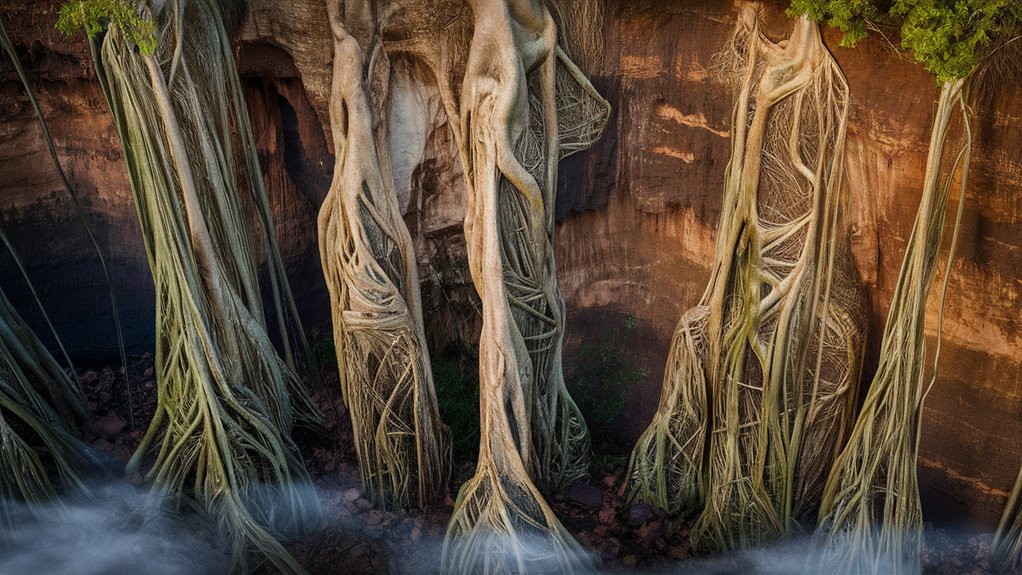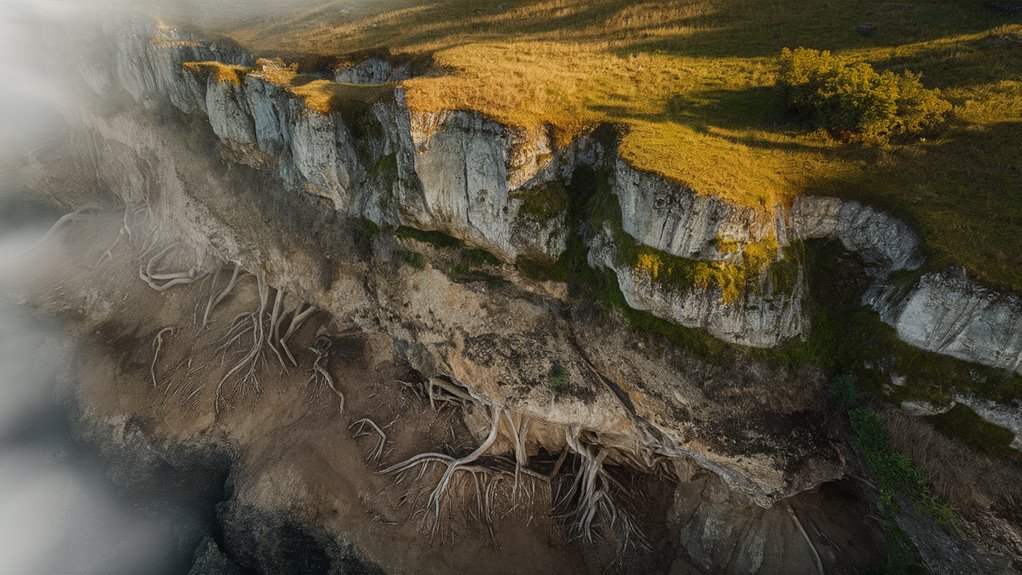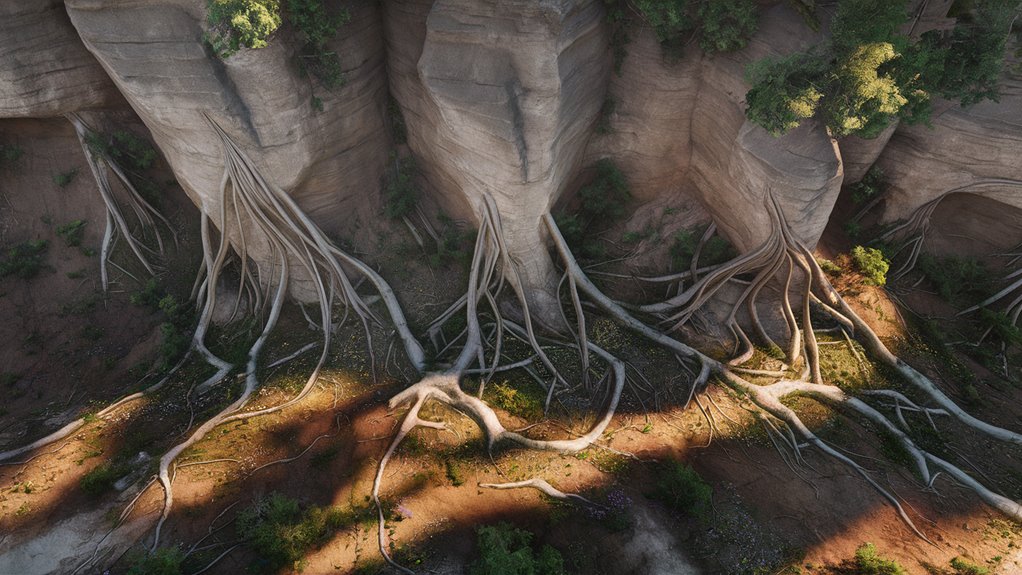
Aerial Root Adaptations in Cliff Ecosystems
Understanding Cliff-Dwelling Plant Survival Mechanisms
The remarkable aerial root systems that dominate cliff faces demonstrate nature’s ingenious adaptations. These specialized roots anchor securely into rock crevices, creating complex networks that extract vital moisture and nutrients from atmospheric sources. The distinctive velamen tissue, characterized by its silvery sheen when moisture-laden, serves as a crucial water-harvesting mechanism.
Microhabitat Formation and Biodiversity
Vertical cliff environments support intricate ecological communities through their unique architecture. The presence of aerial roots contributes to the development of specialized microhabitats, fostering biodiversity in these challenging vertical landscapes. This dynamic ecosystem supports a diverse array of species adapted to life on steep terrain.
Field Research and Documentation Methods
Scientific observation of these cliff-dwelling communities requires precise documentation techniques. Using high-powered optics and detailed field notes, researchers track the root-rock interactions and catalogue species distribution patterns. This methodical approach reveals crucial insights into aerial root adaptation and ecosystem stability.
Frequently Asked Questions
Q: How do aerial roots absorb water from air?
A: Velamen cells on aerial roots capture atmospheric moisture through specialized absorption tissues.
Q: What role do aerial roots play in cliff ecosystems?
A: They provide structural support, create microhabitats, and facilitate nutrient cycling in vertical environments.
Q: How do plants anchor themselves to cliff faces?
A: Through specialized root adaptations that penetrate rock crevices and develop strong adhesive properties.
Q: What types of plants typically develop aerial roots?
A: Epiphytes, climbing vines, and certain specialized cliff-dwelling species commonly develop aerial roots.
Q: How do aerial roots contribute to biodiversity?
A: They create stable anchor points and microhabitats that support various organisms in cliff ecosystems.
Understanding Aerial Roots

Understanding Aerial Roots: Nature’s Remarkable Support System
What Are Aerial Roots?
Aerial roots are specialized plant structures that develop above the ground, emerging from the stems or branches of certain plant species.
These remarkable adaptations serve multiple vital functions in plant survival and growth, making them essential features of many tropical and subtropical species.
Functions and Characteristics
Aerial root systems demonstrate remarkable versatility in their roles:
- Moisture absorption directly from 메이저사이트 the surrounding air
- Nutrient collection from the environment
- Structural support for growing plants
- Anchoring capability in challenging environments
Types of Plants with Aerial Roots
Many tropical species utilize aerial roots, including:
- Banyan trees
- Orchids
- Mangroves
- Philodendrons
- Monstera plants
Ecological Significance
These specialized root structures play crucial roles in ecosystem health and biodiversity.
They create unique habitats for various organisms while contributing to the structural integrity of forest canopies and providing essential pathways for nutrient cycling.
FAQs About Aerial Roots
Q: How do aerial roots absorb water?
A: Aerial roots absorb moisture through specialized cells called velamen, which capture water vapor and nutrients from the air.
Q: Can aerial roots be pruned?
A: Yes, aerial roots can be carefully pruned without harming the plant, though it’s best to preserve them for optimal plant health.
Q: Do all tropical plants have aerial roots?
A: No, aerial roots are specific to certain plant species adapted to tropical and subtropical environments.
Q: How long can aerial roots grow?
A: Aerial root length varies by species, with some reaching several meters in length.
Q: Do aerial roots need soil to survive?
A: Many aerial roots can function without soil contact, though some species eventually seek ground connection for additional support and nutrients.
The Role of Bluffs in Ecosystems
The Critical Role of Bluffs in Ecosystem Diversity
Natural Architecture and Ecological Impact
Bluffs stand as towering geological formations that significantly influence their surrounding ecosystems.
These natural structures create essential microhabitats that support diverse plant and animal communities. The exposed rock faces and protected recesses form ideal conditions for specialized species adaptation and survival in challenging environments.
Biodiversity and Habitat Creation
Vertical ecosystems flourish along bluff faces, where specialized plant species anchor themselves in rock crevices.
These formations serve as crucial wildlife corridors and provide essential nesting sites for various bird species. The unique physical characteristics of bluffs create natural shelter zones that protect smaller mammals from predators and extreme weather conditions.
Environmental Benefits and Ecosystem Services
Bluff ecosystems contribute significantly to regional biodiversity by:
- Creating moisture capture zones
- Supporting rare plant communities
- Providing critical wildlife habitats
- Maintaining ecological connectivity
- Offering natural climate regulation
Frequently Asked Questions
Q: What makes bluffs important for ecosystem diversity?
A: Bluffs create unique microclimates and provide specialized habitats for rare species.
Q: How do bluffs support wildlife populations?
A: They offer nesting sites, shelter, and protected corridors for various animal species.
Q: What types of plants grow on bluffs?
A: Specialized vegetation adapted to vertical growing conditions, including drought-resistant plants and unique wildflower species.
Q: Why are bluffs considered biodiversity hotspots?
A: Their varied topography creates multiple microhabitats supporting diverse plant and animal communities.
Q: How do bluffs contribute to environmental stability?
A: Bluffs regulate local climate conditions, capture moisture, and maintain ecological corridors for species movement.
Ecological Significance and Conservation Value
These ancient formations function as natural biodiversity centers, enriching surrounding landscapes through their unique geological and biological features.
Their presence creates vital ecological niches that contribute to the overall health and resilience of regional ecosystems.
Observational Techniques in the Field

Advanced Field Observation Techniques for Natural Ecosystems
Essential Field Observation Methods
Systematic observation of natural ecosystems requires a carefully planned approach combining traditional and modern techniques.
Field researchers employ specialized equipment including high-quality binoculars, detailed field notebooks, and professional documentation tools to capture vital ecosystem data.
Documentation Strategies
Scientific observation demands 릴이 제어불능이 되는이유 meticulous recording of environmental patterns.
Researchers implement multi-layered documentation through:
- Detailed field notes
- Scientific sketching
- Professional photography
- Digital mapping
- Environmental sound recording
Advanced Observation Skills
Developing keen observational abilities requires mastering the art of patient observation.
Field scientists position themselves strategically to monitor:
- Wildlife behavior patterns
- Plant-animal interactions
- Ecosystem dynamics
- Environmental changes
- Species distribution
FAQ: Field Observation Techniques
Q: What essential equipment is needed for field observation?
A: Core equipment includes binoculars, field notebooks, cameras, GPS devices, and weather-resistant gear.
Q: How long should observation sessions last?
A: Typical sessions range from 2-4 hours, depending on research objectives and environmental conditions.
Q: What’s the best time for field observations?
A: Dawn and dusk offer peak activity periods, though timing varies by species and ecosystem.
Q: How do you document wildlife without disturbing them?
A: Use telephoto lenses, maintain safe distances, and employ camouflage techniques when necessary.
Q: What data should be recorded during observations?
A: Record date, time, weather conditions, species observed, behaviors, locations, and relevant environmental factors.
Implications for Conservation Efforts
Conservation Implications for Ecosystem Management
Understanding Ecosystem Interconnectedness
Meticulous field observations reveal the complex web of relationships within ecosystems, highlighting the critical importance of conservation.
Aerial root networks create natural support systems that sustain biodiversity hotspots, demonstrating how single elements contribute to broader ecosystem health. These intricate connections form the foundation of resilient natural habitats.
Impact of Species Loss on Environmental Balance
The cascading effects of species decline ripple through entire ecosystems, disrupting established ecological relationships.
When keystone species disappear, particularly among plant-pollinator networks, the impact extends far beyond individual species.
Ecosystem stability depends on maintaining these delicate biological interactions that have evolved over millennia.
Sustainable Resource Management
Traditional ecological knowledge and indigenous conservation practices offer valuable insights into sustainable ecosystem management.
These time-tested approaches demonstrate how human communities can coexist with natural systems while preserving biodiversity and ecological function.
Implementing these practices alongside modern conservation strategies creates more effective habitat protection methods.
Frequently Asked Questions
Q1: Why is ecosystem interconnectedness important for conservation?
A: Ecosystem interconnectedness ensures species survival, maintains biodiversity, and supports natural resource sustainability.
Q2: How does species loss affect ecosystem stability?
A: Species loss disrupts pollination networks, food chains, and habitat structure, potentially triggering cascade effects throughout the ecosystem.
Q3: What role do indigenous practices play in conservation?
A: Indigenous practices provide proven methods for sustainable resource management and long-term ecosystem preservation.
Q4: How can we measure ecosystem health?
A: Ecosystem health is measured through biodiversity levels, species populations, and the stability of ecological relationships.
Q5: What’re the key priorities for modern conservation efforts?
A: Modern conservation priorities include protecting biodiversity hotspots, maintaining ecosystem services, and implementing sustainable management practices.
Case Studies of Aerial Root Impacts

Aerial Root Impact Case Studies: Ecosystem Effects and Environmental Significance
Mangrove Forest Case Study
Mangrove ecosystems along the Caribbean coast demonstrate the profound impact of aerial root systems on coastal environments. These specialized roots act as natural infrastructure, providing critical shoreline stabilization while creating essential nursery habitats for diverse marine species.
The complex root architecture performs dual functions of nutrient retention and erosion prevention, maintaining vital coastal ecosystem services.
Rainforest Strangler Fig Analysis
In Brazilian rainforest environments, strangler fig specimens showcase remarkable aerial root adaptation. Their distinctive root networks demonstrate advanced resource acquisition strategies, accessing both atmospheric moisture and soil nutrients.
This specialized growth pattern creates microhabitat networks supporting extensive biodiversity while illustrating natural competitive dynamics in forest ecosystems.
Ecosystem Health Indicators
Aerial root systems serve as key indicators of ecosystem resilience. Research demonstrates their significant contribution to:
- Soil stabilization
- Nutrient cycling
- Habitat creation
- Species diversity support
- Environmental adaptation
Frequently Asked Questions
Q: How do aerial roots contribute to ecosystem stability?
A: Aerial roots enhance ecosystem stability through soil reinforcement, nutrient capture, and habitat creation for diverse species.
Q: What role do mangrove aerial roots play in coastal protection?
A: Mangrove aerial roots reduce coastal erosion, buffer wave impact, and create protected nursery areas for marine life.
Q: How do strangler fig aerial roots affect forest dynamics?
A: Strangler fig aerial roots create new canopy structures, facilitate nutrient acquisition, and influence forest succession patterns.
Q: What environmental benefits do aerial roots provide?
A: Aerial roots improve soil quality, enhance biodiversity, protect against erosion, and support ecosystem resilience.
Q: Why are aerial roots important for species conservation?
A: Aerial roots create specialized habitats, maintain environmental conditions, and support diverse species populations in various ecosystems.


